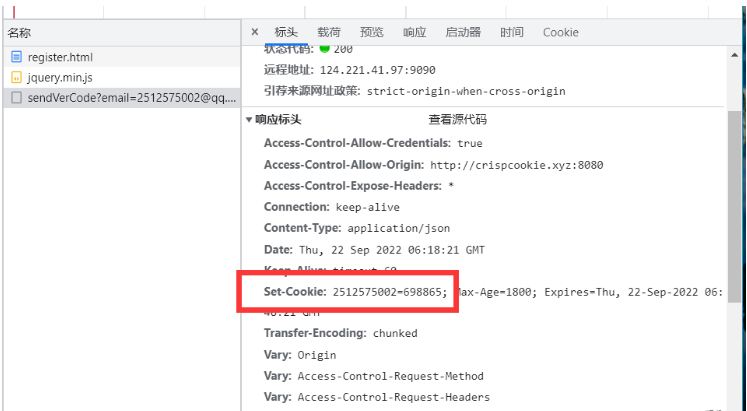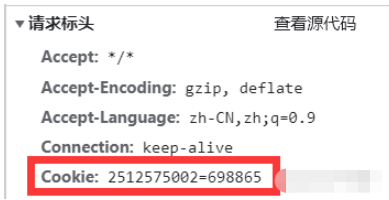 Java
Java
 javaTutorial
javaTutorial
 How to solve the problem of Ajax cross-domain and cookie failure in SpringBoot
How to solve the problem of Ajax cross-domain and cookie failure in SpringBoot
How to solve the problem of Ajax cross-domain and cookie failure in SpringBoot
When writing the login registration page of my own project, because my registration and password change functions use email verification, the backend will add a cookie to the response data when sending the verification code
Cookie cookie = new Cookie(toEmail.split("@")[0],verCode);
cookie.setMaxAge(30*60);
response.addCookie(cookie);and then When you click to register or change your password, the backend will obtain the cookie from the request to obtain the email and verification code information
Cookie[] cookies = request.getCookies();
When testing locally, the cookie can be correctly added to the response and can also be obtained correctly


But when I packaged the project to the cloud and then performed ajax access, a problem occurred. Cookie acquisition failed!
There is clearly set-Cookie in the response header, but Cookie cannot be found in the second request header
The server fails to obtain the cookie and reports an error. The function of using cookies to register and change passwords is invalid. After searching for the document, I found that the error originated from the cross-domain cookie loss problem of springboot and ajax. Since I am new to the backend,
I only post my solution here
1. The ajax request needs to carry xmlhttp.withCredentials = true; #3. Set the response header for the response in the api in the Controller, key
is "Access-Control-Allow-Origin" access control allowed source, http request header information, set allowed resource sharing (cross-domain ) The sourcevar xmlhttp = new XMLHttpRequest();
xmlhttp.withCredentials = true;
xmlhttp.open("GET", readyUrl, true);
xmlhttp.send();value is request.getHeader("Origin"), which represents the protocol and domain name
combination of the page where the currently requested resource is located Together they mean Allow the current requested resource to access back-end resources across domains
After setting these three parts, I can get the cookie again2022 -12-09 Update:
Found a more concise and convenient method to add a cross-domain request filterUsed the StringUtils.isEmpty method of the Druid data pool dependency package , if an error is reported, just write a replacement yourself
package com.crisp.myblog.config;
import org.springframework.context.annotation.Configuration;
import org.springframework.web.servlet.config.annotation.CorsRegistry;
import org.springframework.web.servlet.config.annotation.WebMvcConfigurer;
@Configuration
public class corsConfig implements WebMvcConfigurer {
@Override
public void addCorsMappings(CorsRegistry registry) {
registry.addMapping("/**")
//是否发送Cookie
.allowCredentials(true)
//放行哪些原始域
.allowedOriginPatterns("这里填你前端代码所在的域名:端口")
.allowedMethods(new String[]{"GET", "POST", "PUT", "DELETE"})
.allowedHeaders("*")
.exposedHeaders("*");
}
}The above is the detailed content of How to solve the problem of Ajax cross-domain and cookie failure in SpringBoot. For more information, please follow other related articles on the PHP Chinese website!

Hot AI Tools

Undresser.AI Undress
AI-powered app for creating realistic nude photos

AI Clothes Remover
Online AI tool for removing clothes from photos.

Undress AI Tool
Undress images for free

Clothoff.io
AI clothes remover

Video Face Swap
Swap faces in any video effortlessly with our completely free AI face swap tool!

Hot Article

Hot Tools

Notepad++7.3.1
Easy-to-use and free code editor

SublimeText3 Chinese version
Chinese version, very easy to use

Zend Studio 13.0.1
Powerful PHP integrated development environment

Dreamweaver CS6
Visual web development tools

SublimeText3 Mac version
God-level code editing software (SublimeText3)

Hot Topics
 PHP and Ajax: Building an autocomplete suggestion engine
Jun 02, 2024 pm 08:39 PM
PHP and Ajax: Building an autocomplete suggestion engine
Jun 02, 2024 pm 08:39 PM
Build an autocomplete suggestion engine using PHP and Ajax: Server-side script: handles Ajax requests and returns suggestions (autocomplete.php). Client script: Send Ajax request and display suggestions (autocomplete.js). Practical case: Include script in HTML page and specify search-input element identifier.
 How to solve the 403 error encountered by jQuery AJAX request
Feb 20, 2024 am 10:07 AM
How to solve the 403 error encountered by jQuery AJAX request
Feb 20, 2024 am 10:07 AM
Title: Methods and code examples to resolve 403 errors in jQuery AJAX requests. The 403 error refers to a request that the server prohibits access to a resource. This error usually occurs because the request lacks permissions or is rejected by the server. When making jQueryAJAX requests, you sometimes encounter this situation. This article will introduce how to solve this problem and provide code examples. Solution: Check permissions: First ensure that the requested URL address is correct and verify that you have sufficient permissions to access the resource.
 How to solve jQuery AJAX request 403 error
Feb 19, 2024 pm 05:55 PM
How to solve jQuery AJAX request 403 error
Feb 19, 2024 pm 05:55 PM
jQuery is a popular JavaScript library used to simplify client-side development. AJAX is a technology that sends asynchronous requests and interacts with the server without reloading the entire web page. However, when using jQuery to make AJAX requests, you sometimes encounter 403 errors. 403 errors are usually server-denied access errors, possibly due to security policy or permission issues. In this article, we will discuss how to resolve jQueryAJAX request encountering 403 error
 How to solve the problem of jQuery AJAX error 403?
Feb 23, 2024 pm 04:27 PM
How to solve the problem of jQuery AJAX error 403?
Feb 23, 2024 pm 04:27 PM
How to solve the problem of jQueryAJAX error 403? When developing web applications, jQuery is often used to send asynchronous requests. However, sometimes you may encounter error code 403 when using jQueryAJAX, indicating that access is forbidden by the server. This is usually caused by server-side security settings, but there are ways to work around it. This article will introduce how to solve the problem of jQueryAJAX error 403 and provide specific code examples. 1. to make
 How to get variables from PHP method using Ajax?
Mar 09, 2024 pm 05:36 PM
How to get variables from PHP method using Ajax?
Mar 09, 2024 pm 05:36 PM
Using Ajax to obtain variables from PHP methods is a common scenario in web development. Through Ajax, the page can be dynamically obtained without refreshing the data. In this article, we will introduce how to use Ajax to get variables from PHP methods, and provide specific code examples. First, we need to write a PHP file to handle the Ajax request and return the required variables. Here is sample code for a simple PHP file getData.php:
 Detailed explanation of where browser cookies are stored
Jan 19, 2024 am 09:15 AM
Detailed explanation of where browser cookies are stored
Jan 19, 2024 am 09:15 AM
With the popularity of the Internet, we use browsers to surf the Internet have become a way of life. In the daily use of browsers, we often encounter situations where we need to enter account passwords, such as online shopping, social networking, emails, etc. This information needs to be recorded by the browser so that it does not need to be entered again the next time you visit. This is when cookies come in handy. What are cookies? Cookie refers to a small data file sent by the server to the user's browser and stored locally. It contains user behavior of some websites.
 Frequently Asked Questions and Solutions about Cookie Settings
Jan 19, 2024 am 09:08 AM
Frequently Asked Questions and Solutions about Cookie Settings
Jan 19, 2024 am 09:08 AM
Common problems and solutions for cookie settings, specific code examples are required. With the development of the Internet, cookies, as one of the most common conventional technologies, have been widely used in websites and applications. Cookie, simply put, is a data file stored on the user's computer that can be used to store the user's information on the website, including login name, shopping cart contents, website preferences, etc. Cookies are an essential tool for developers, but at the same time, cookie settings are often encountered
 How to find cookies in your browser
Jan 19, 2024 am 09:46 AM
How to find cookies in your browser
Jan 19, 2024 am 09:46 AM
In our daily use of computers and the Internet, we are often exposed to cookies. A cookie is a small text file that saves records of our visits to the website, preferences and other information. This information may be used by the website to better serve us. But sometimes, we need to find cookie information to find the content we want. So how do we find cookies in the browser? First, we need to understand where the cookie exists. in browser





